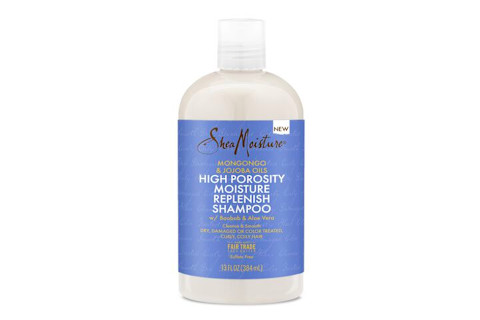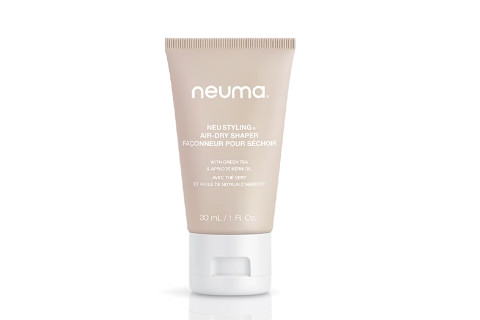What Is High Porosity Hair? Plus, How To Care For It According To Hairstylists

There is no shortage of descriptors that we can associate with our hair—each coming with a unique set of benefits, attributes, challenges, and treatment needs. Even if you find two people with fairly similar texture patterns, their hair density, scalp needs, strand thickness and length will add up to very different care and styling routines.
Hair porosity is one of those tricky little descriptors that can play a big role in the overall feel and appearance of your hair. In general, you'll fall into the category of low or high porosity—or somewhere in between.
To come, how to tell where you fall and a guide to caring for high porosity hair.
What is high porosity hair?
Porosity refers to how susceptible your hair is to water: essentially, to what degree the outer layer of the strand takes in or keeps out water.
"The outer layer of the hair strand is called the cuticle layer. The cuticle layer is made of little tiny cuticles that lie slightly over one another," hairstylist Danielle Malary explains. Think of this as you would shingles on a roof—and your porosity comes from how tightly those shingles are packed together.
"Hair porosity describes how the hair's cuticle absorbs and holds on to moisture in its pores—hence, the term porosity," says hairstylist Miko Branch, co-founder of hair care brand Miss Jessie's. So when your hair is high on the porosity spectrum, it means it's very porous, and thus the cuticles are more sparse than they are dense, so it's able to absorb a lot of water.
In contrast, you can have low porosity hair: "When someone has low porosity hair, the hair tends to have trouble absorbing moisture because the hair is resistant to water," says Malary. "When the hair has low porosity, the cuticles are packed so tightly onto each other, it makes it very difficult for moisture or water to penetrate the strand."
Can hair porosity change?
Even if you had low porosity hair in the past, that porosity can change. "According to the National Center for Biotechnology Information (NCBI)1, hair that is extremely porous are hair strands that are damaged by things such as UV exposure, hair bleaching, chemical relaxers, or intense heat over long periods of time," explains certified trichologist and founder of Alodia Isfahan Chambers-Harris.
"Exposure to these things leads to increase in porosity levels causing your hair to have high porosity," Chambers-Harris adds. So the more you expose your hair to UV, heat, and chemical damage, the more porous it becomes.
Characteristics of high porosity hair
Still, it can be hard to tell if your strands are highly porous right now. Below, a few signs you may fall into this category:
How tell if you have high porosity hair
Still unsure? Call upon one of the following tests:
The water test
The classic test to see what your porosity is is called the water test. It's super simple: Grab a glass of water, and a strand of hair (like from your brush). Drop in the hair and see if it floats or sinks to the bottom. If it floats, you have low porosity hair. If it sinks to the bottom, you have high.
The finger test
"Take a small section of hair at the crown area, holding onto the ends, and slide your thumb and index finger up and down the hair strand toward the scalp. If hair feels rough the porosity level is higher," certified trichologist and founder of Colour Collective Kerry Yates explains.
Visit a stylist
If you're still not sure, it's best to visit a stylist. These experts can help you identity your hair porosity level and ensure you're using the best routine for your strands.
How to care for high porosity hair
High porosity hair is also highly sensitive, so take these care tips seriously:
- Skip the harsh treatments and hot tools: "Just like the texture of hair is genetic, so is the porosity of hair. However, there are also other ways to alter your hair's porous ability (porosity) and zap away its moisture—using products with drying agents, chemical relaxer treatments, overuse of heating tools (i.e., blow dryers, flat irons, etc.), and damaging sun exposure," says Branch. "When you have high porosity hair, it can easily become damaged, dull, broken, tangled, weak, and frizzy from all this." This is because when you use harsh treatments or daily high heat, you can actually damage and remove some of that outer layer of the cuticle, making it more porous.
- Only use low heat or air dry: "Freshly washed, high porosity hair will absorb the moisture very quickly—and dry very quickly," says Branch. Take advantage of this key characteristic. Since it dries easier and quicker, you likely won't need to blast it with high-wattage blow dryers to get the job done. Frédéric Fekkai, founder and CEO of FEKKAI Brands, agrees: "For high porosity hair, you should use low heat, so, therefore, best to let hair air dry."
- Protect the strand: Because the hair's outer is so fragile, don't subject it to too much wear and tear via overstyling, brushing, and washing. And regularly coat the hair with hydrating products to help reinforce that outer cuticle. "Three words: moisturize, moisturize, moisturize. Locking in that much-needed protective moisture to strengthen high porosity hair results in stronger, supple, shiny, healthy, and super happy hair," says Branch.
- Use color-protecting shampoos and conditioners: "Porous hair is difficult to color," says Fekkai. It makes sense: When you dye hair, the formula is depositing pigments between the circles into the hair shaft, resulting in your new hue. When your cuticles are dense, these pigments stay nestled in there; on the other hand, when the cuticles are looser, the pigments fall out (yes, literally fall out) easier. Keep color-safe products on hand to keep your color vibrant longer.
- Stick to creamy, dense products: "The challenge of having high porosity hair is that since the outer layer is fragile, the hair is unprotected," says Branch. "This type of hair requires super-creamy, nutrient-rich hair care products that seal in moisture—from cleansers and conditioners to leave-ins and deep treatments to everyday styling."
- Use a pre-shampoo treatment: "The good news is that when you have high porosity hair, essential proteins and hydrating oils are also easily absorbed—so take advantage of it," says Branch. Essentially, the gaps in the cuticle are able to suck in all the goodies in your products that lower porosity hair will often block or keep out. For this reason, "Put a treatment mask on before shampooing," says Fekkai. He agrees that you should be opting for one with dense nutrients, oils, and butters: "More porous hair requires use of products with less water," he says.
- Opt for low-effort styles close to your natural pattern: This is more about effort put in for lasting payoff: "Porous hair does not hold style as long," says Fekkai. Given you know that your hair likely won't hold shape for hours on end, perhaps stick as close to natural as possible—it will save you a headache later when your hair is falling flat or out of shape. Or for a special occasion, in which a 'do seems in order, consider using higher-hold styling products.
The best ingredients for high porosity hair
When shopping for high porosity hair products, look for these ingredients:
- Proteins or bond-builders
- Moringa seed oil
- Shea butter
- Aloe vera
- Jojoba oil
- Fatty acids
- Coconut oil
- Squalane
The best products for high porosity hair
Wash and styling products are often marketed toward your hair type, not necessarily the porosity level of your hair. To narrow down your search, experts explain what type of products you should use below.
Leave-ins
You may sense a theme here: Highly porous hair is begging for moisture. To ensure your strands stay soft post-rinse, add a leave-in conditioner to your routine. Look for a rich, creamy formula rather than something light and water-based.
Curl cream
As mentioned above, letting your strands air dry is much preferred. For those with curly strands, have a curl cream (read: not just a curl gel) on hand for shaping that's both nourishing and functional. If you choose to diffuse your curls, use a heat protectant beforehand.
Hydrating shampoos
Yates notes that all products used on highly porous hair should be hydrating—yes, including your shampoo. Look for a rich formula, preferably one that's silicone free, Yates adds. One expert pick: Shea Moisture High Porosity Moisture Replenish Shampoo.
Conditioner
Chambers-Harris recommends using deep conditioners (or hair masks) rather than lightweight formulas if you have highly porous strands. This type of product often contains less water and more nutrient-dense butters—perfect for highly absorbent hair.
Repair treatments
"Damaged hair can lose its luster by being porous like scratched glass," celebrity hairstylist Bradley Leake explains. One way to ensure your hair gets repaired is to use bond-building products like the Epres Bond Repair Treatment weekly.
Best products for high porosity hair
FAQ
What are signs of high porosity hair?
Your hair gets wet quickly.
Your hair dries quickly.
Your hair tangles easily.
Your hair generally feels dry and rough.
Your hair is often frizzy.
Your hair breaks easily.
Your hair doesn't hold style very long.
What is high porosity hair?
"Hair porosity describes how the hair's cuticle absorbs and holds on to moisture in its pores—hence, the term porosity," says hairstylist Miko Branch, co-founder of hair care brand Miss Jessie's. So when your hair is high on the porosity spectrum, it means it's very porous, and thus the cuticles are more sparse than they are dense, so it's able to absorb a lot of water.
What should I avoid with high porosity hair?
When caring for high porosity hair, do your best to avoid excessive heat styling, UV exposure, and damaging chemical treatments. Rather than using lightweight leave-in products, opt for nutrient-dense creams and oils—this way, your highly porous strands will soak up all of the ingredients needed to repair any damage.
The takeaway
Highly porous hair gets wet quickly but dries quickly too. To properly care for your highly porous strands, use dense, nutrient-rich hair care products and limit your exposure to heat and chemical hair dye if you can. Not sure where to start? Get a bond-building treatment—here are a few great options to try.




